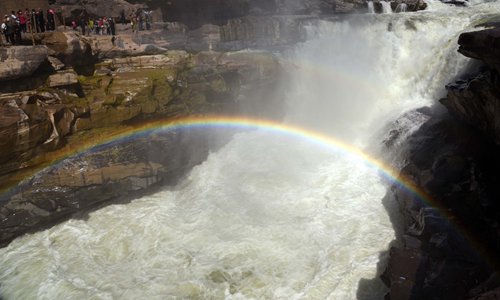○ Some experts warn that limiting the Yellow River's natural silt could upset the region's
Tourists stand at Hukou Waterfall on the Yellow River to see the new, clean river with a rainbow. Photo: IC
The Yellow River, China's "mother river" known for thousands of years for its heavy concentrations of silt and sediment, is reported to have become permanently clear in some stretches. A rarity in history, the recent phenomenon has aroused fierce discussions and debates between environmentalists and ecologists. A recent report from Outlook Weekly magazine revealed that the Yellow River has become gradually clear, with dwindling sediment concentrations, starting in the year 2000. The river is now clean in the 1200-kilometer middle portion of the river, between Hohhot, Inner Mongolia Autonomous Region, and Taohuayu, Henan Province, which is the cut-off point between midstream and downstream.
It means that, together with the clear upstream, 80 percent stretches of the river are now totally clear in non-flood seasons. Throughout history, there have only been 43 reported instances of the Yellow River becoming clear. And yet, this clarity never lasted more than 20 days. The new phenomenon, which has lasted for years, is the longest duration in its history. This, of course, has excited experts, as it is considered the successful result of several generations worth of consistent efforts in "harnessing" the river, be it vegetation conservation or controlling silt and sediment, which can be traced back to 1946. But considering the environmental significance of the Yellow River, the difficulty in taming it and the potential dangers it still poses, there is no definitive consensus about whether this new clarity is a good or bad thing. Experts have reached a general consensus regarding the reasons for the new clarity, but they still hold different views as to how it will affect the environment in and around the river and other possible risks.

Reduced sediment
Compared with the 43 other times that the Yellow River has become clear, experts agree that those were probably accidental. Today's clarity is something altogether different and dramatic. But the Yellow River's new-found clarity is being attributed to China's ongoing efforts to conserve soil and water and the widespread use of reservoirs, experts have analyzed. For centuries if not millennia, the Yellow River carried 1.6 billion tons of sand on average every year. But between 2000 and 2015, the number suddenly dropped to 264 million. The upstream conservation of soil and water along the Loess Plateau played a significant role in this.
Sword of Damocles
There is also disagreement over how long the Yellow River will stay clear. Qi Pu, who used to be an engineer for the YRCC, believes it will become a trend for the Yellow River to become clear now that sand flow has been dwindling year on year.
For the full article, please visit Global Times:
